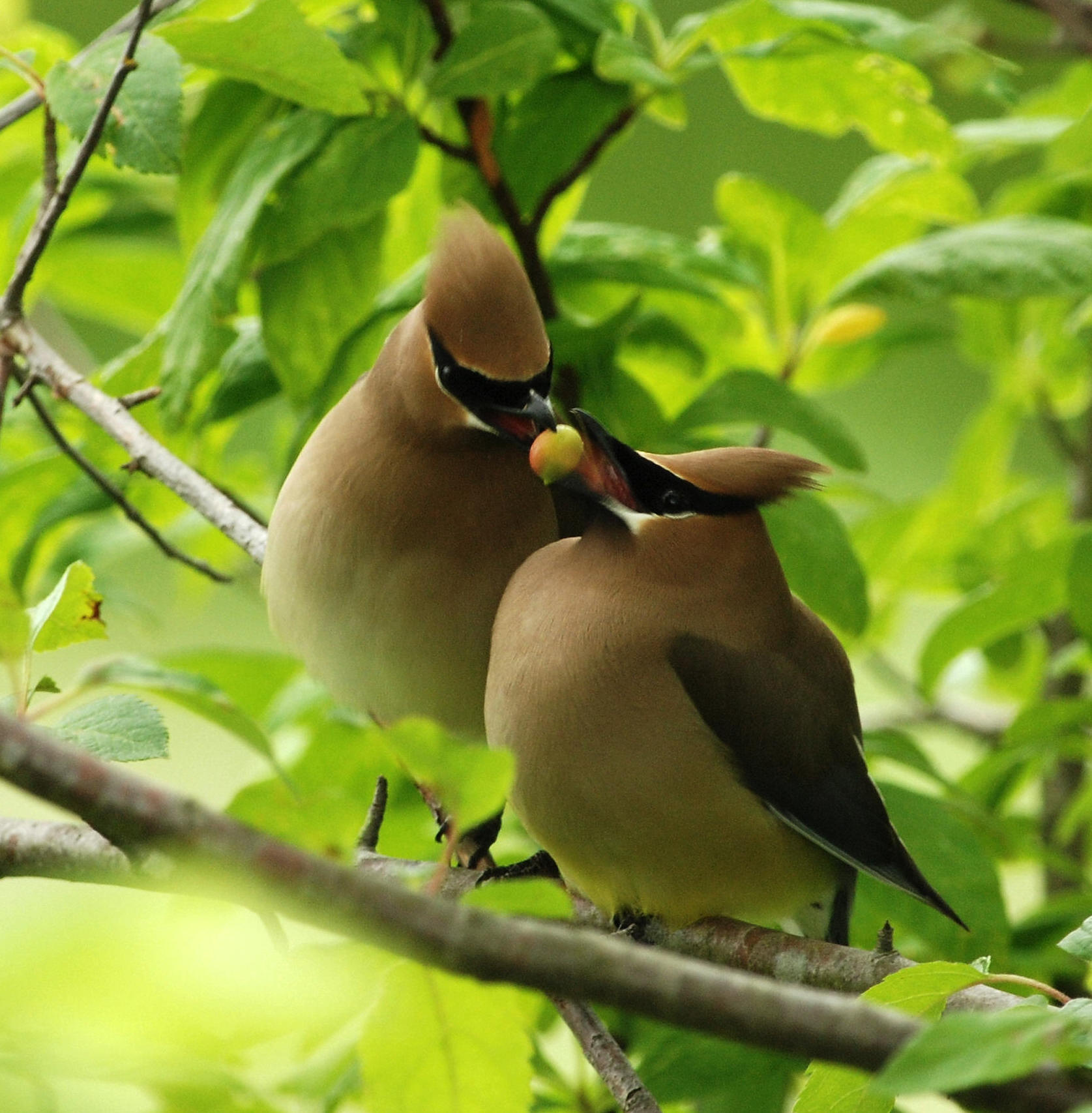The Wild Lives of Wildlife
Tim Iverson
Seasonal Naturalist
Cunningham Falls State Park
|

Cedar Waxwings pass a berry back
and forth during courtship
|
(2/2014) February is synonymous with love. With Valentine’s Day fast approaching, we humans will be putting final touches on gifts or planning out thoughtful romantic gestures if we’ve been diligent. Perhaps you’re not as forward thinking, and you’ll scramble at the last second to pick up a dozen red roses, a sappy card, and some chocolates in heart
shaped box. Either way these are part of a larger ritual display. While we’re all familiar with the birds and the bees, animal reproduction is as diverse as the kinds of critters that copulate (which are all of them).
Encyclopedia Brittanica defines courtship as "in animals, behaviour that results in mating and eventual reproduction. Courtship may be rather simple, involving a small number of chemical, visual, or auditory stimuli; or it may be a highly complex series of acts by two or more individuals, using several modes of communication." In humans we tend to
think of courting behavior in the context of social customs and cues. Animals, on the other hand, do everything instinctually without the help of Cupid or conversation heart candies.
Some customs are well known, but are actually less common than originally thought. The female Praying Mantis is known for devouring the head of the male after the act is complete. However, this is not necessarily always the case. When two mantises meet and care very much for one another they perform intimate rituals. They will gentle caress one
another’s antennae and dance together. After the courting is complete they get down to business. About a third of the time the female will eat the head of the male. Researchers still are unsure of the reasoning behind this behavior, but it is likely to provide nutrition for the newly expecting mother. Others think it’s simply because the female gets confused and mistakes the
male for prey. Either way, females will usually only perform sexual cannibalism when starving. The Praying Mantis isn’t the only one with a robust sexual appetite though.
Black Widows are a well known species of venomous spider. Male widow spiders, which are much smaller than their counterparts, will prep for the intimate embrace by spinning a small web coated in sperm. After coating this web in semen he will coat his palps, small appendages adjacent to the mouth, with his sperm. At this point he will set off into the
world in search of Mrs. Right. Once he finds her he will serenade her by performing a vibratory song—dancing and plucking the strings simultaneously. As this progresses he will slowly approach her and tenderly tap on her body. Eventually he will insert his palps into her reproductive organs. Once the relationship has been consummated the female will make the male into a
snack. Widow spiders aren’t the only ones who are little batty in the sack though.
Bats are an unusual animal in general. They are the only flying mammal, and because of that they have some high profile antics. Copulation varies immensely from species to species. Hibernating species will meet their mates at their hibernation sites. Males and Females will form swarms and chase each other around performing amazing aerobatics. Other
species, like the Horseshoe Bat, are more discrete. The females will sidle up to the males in individual roosts to procreate. Male Hammerheaded Bats will line up in trees along a river bank and "honk" at the females passing by. Meanwhile, the male Sac-Winged Bat will hover in place in front a female to show off flying prowess and to waft pheromones towards her. Some bats like
to mix things up by hopping on the good foot to do the bad thing upside-down. Others will just pair off in rock crevices and cave walls. Short-Nosed Fruit Bats and Indian Flying Foxes have been found to perform oral stimulation in order to protract the act. While bats are busy bees exhibiting amorous behavior others are eager to woo a mate too!
The Honey Bee is usually noted for their dwindling population numbers. While science hasn’t come to a definitive answer for the reason behind falling numbers they have found out one reason for the demise of a male bee. Generally speaking male honey bees exist to serve one purpose – to mate with the queen. The male bee, called a Drone, will give up his
life to serve his purpose in a form of sexual suicide. When ready the queen will take flight, and males will give chase and swarm around her. A male will eventually grab a hold of her and insert himself. The drone will then inseminate the queen with a contraction so powerful his genitalia brakes off inside the queen and he will fall to ground where he will die shortly
thereafter. The queen will take several mates throughout this airborne adventure, which will take place only once in her life. From these lucky suitors she will store the sperm up to use throughout the rest of her life.
As we’ve seen there are many way to show your loved ones you care about them. From demonstrating amorous intentions to wild escapades that end ones’ life, love takes many forms. Either way we all do what comes natural and Valentine’s Day is just one of our more complex courting behaviors that aims to achieve the same things as wafting pheromones or
massaging antennae. Don’t forget to show your mate you care by whatever means is appropriate to the species. Grab a bottle of wine, snag a card, and share a candlelit dinner because after all a little romance never killed anyone – except widow spiders, honey bees, and praying mantises.
Read other articles by Ranger Tim Iverson